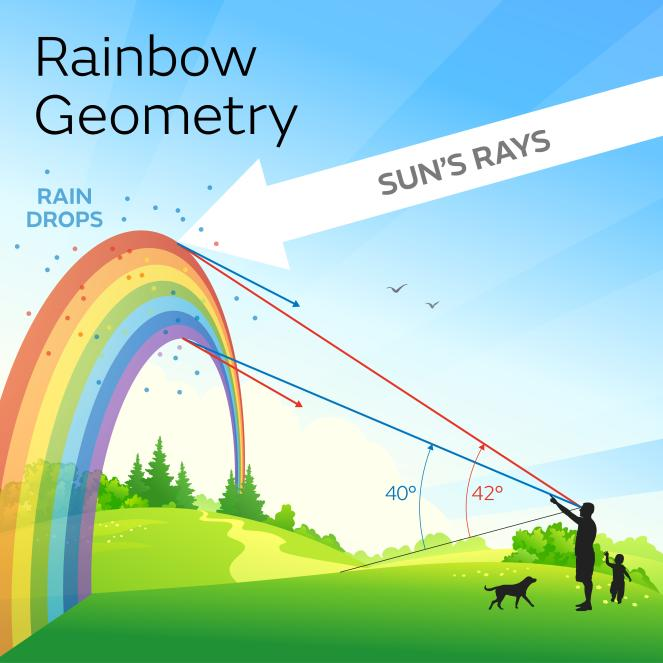Biodiversity & Environment
Rainbow & Climate Change
- 04 Nov 2022
- 5 min read
For Prelims: Rainbow Formation
For Mains: Rainbow Formation and it’s linkage with Climate Change
Why in News?
Recently, a research has found out that the changes in cloud cover and liquid precipitation due to increased greenhouse gas emissions are projected to lead to a net increase in mean global annual rainbow days.
- Mean days of rainbows are expected to go up globally by 4.0–4.9% in a year by 2100.
What has the Study Revealed about Rainbows?
- Areas with Lesser Rainbows:
- Around 21–34% of land areas will lose rainbow days.
- Areas that will lose rainbow days are projected to have lower total precipitation by 2100, except those in Central Africa, Madagascar and central South America.
- All are projected to have more annual dry days and less total annual cloud cover.
- Areas with Higher Rainbows:
- Around 66–79% will gain rainbow days under higher emission futures.
- India is one of the countries where the number of rainbow days will increase.
- African countries like Mali, Niger, Chad, Sudan and Ethiopia are also likely to experience more rainbow days.
- Rainbow gain hotspots are mostly located at higher latitudes or at very high elevations, like the Tibetan Plateau, where warming is predicted to lead to less snow and more rain.
- Two rainbow gain hotspots namely, eastern Borneo and northern Japan, will see overall precipitation increase but more dry days per year.
How is Rainbow & Climate Change Inter-related?
- About:
-
- A rainbow is a common atmospheric optical phenomenon. It is a multicoloured arc in the sky that results when water droplets refract sunlight.
- When sunlight hits a rain droplet, some of the light is reflected. The electromagnetic spectrum is made of light with many different wavelengths, and each is reflected at a different angle. Thus, spectrum is separated, producing a rainbow.
- Rainbows can also be viewed around fog, sea spray, or waterfalls.
- It is an optical illusion; it does not actually exist in a specific spot in the sky.
- Rainbows are the result of the refraction and reflection of light.
- Both refraction and reflection are phenomena that involve a change in a wave's direction.
- A refracted wave may appear "bent", while a reflected wave might seem to "bounce back" from a surface or other wavefront.
- The colors on a primary rainbow are always in order of their wavelength, from longest to shortest: red, orange, yellow, green, blue, indigo and violet.
- A rainbow is a common atmospheric optical phenomenon. It is a multicoloured arc in the sky that results when water droplets refract sunlight.
- Linkage with Climate Change:
- Human activities such as burning fossil fuels are warming the atmosphere, which changes patterns and amounts of rainfall and cloud cover.
- Climate change will alter the distribution of rainbow occurrence by affecting evaporation and convergence of moisture.
- This alters patterns of precipitation and cloud cover.
UPSC Civil Services Examination Previous Year Question
Q. Rainbow is produced when sunlight falls on drops of rain. Which of the following physical phenomena are responsible for this? (2013)
- Dispersion
- Refraction
- Internal reflection
Select the correct answer using the codes given below:
(a) 1 and 2 only
(b) 2 and 3 only
(c) 1 and 3 only
(d) 1, 2 and 3
Ans: (d)
Exp:
- A rainbow is a meteorological phenomenon that is caused by reflection, refraction and dispersion of light by water droplets resulting in a spectrum of light appearing in the sky.
- It is a natural spectrum appearing in the sky after a rain shower. It is caused by dispersion of sunlight by tiny water droplets, present in the atmosphere.
- Rainbow is always formed in a direction opposite to that of the Sun. The water droplets act like small prism. They refract and disperse the incident sunlight, then reflect it internally, and finally refract it again when it comes out of the raindrop. Due to the dispersion of light and internal reflection, different colours reach the observer’s eyes. Hence, 1, 2 and 3 are correct.
- Therefore, option (d) is the correct answer.
Source: DTE







